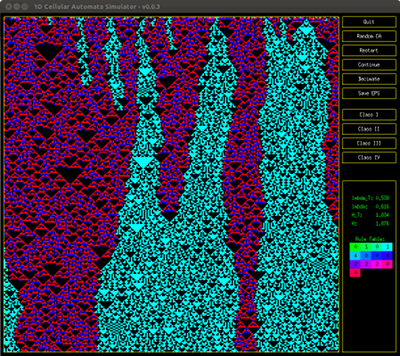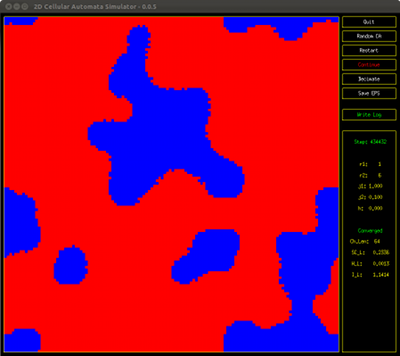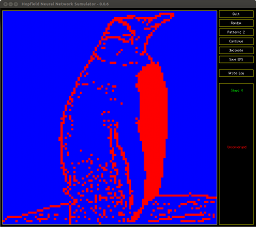Last Updated: Mar / 18 / 2013
1D Cellular Automata Simulator
© 2012 Aaron Vose and Paul Giblock

Download the current version with source code here:
casim-0.0.5.tar.gz
casim1d-0.0.3.tar.gz
I suppose this page will house the Cellular Automata simulator related
tools written for COCS 527 taught by Dr. MacLennan at UTK. He did
allow students to use the CA simulator of their choice, but Paul and I
found most of the extant tools to be severly lacking in one or more
respects. Thus we created our own simulator with the following
features and advantages:
- Our GUI clearly displays the CA rule table along with a number of
statistics based on the rules, such as lambda, lambda_T, entropy, and
entropy_T. This allows one a real-time view of the CA rules and their
properties.
- All the lambda/etc. values are also written to the standard
output log when a classification is chosen. Thus, recording of the CA
rule table and dependent statistics is extremely easy.
- Class I simulations are easily detected by our simulator, however
Class II simulations can often look chaotic without much repetition.
Our simulator has an adjustable history check to see if the newest
created state matches any previous one, even if there has been a
rotation -- this allows easy detection of slow moving horizontal
gliders. Thus our simulator is able to identify Class II CA runs that
would easily be incorrectly classified as Class III.
- The ability to export the cell space as an encapsulated
postscript (EPS) image, as well as resuming from these same EPS files.
These are vectorized images appropriate for display at any DPI.
- When one clicks with the left mouse button in the cell or cell
history display area, a "zoom box" overlay is displayed which shows a
much closer view of the area under the mouse. One can also click and
drag for this feature as well. Numerical cell values are also
displayed.
2D Cellular Automata Simulator:
© 2012 Aaron Vose and Paul Giblock

The 2D CA simulator below implements an "Activator/Inhibitor" model
for each cell where other cells within an internal area contribute to
the activation of the cell, while cells in an outer area contribute to
the inhibition of the cell.
The 2D simulator has a very similar code base as the 1D version, so
both the 1D and 2D CA simulators have been merged into one package.
Both the 1D and the 2D versions of the simulators are contained in the
one package below.
Download the current version with source code here:
casim-0.0.5.tar.gz
Some Features of the 2D CA simulator include:
- The ability to automatically detect convergence and calculate a
number of measures of the cell state once converged, such as
correlation, entropy, and mutual information at a number of
lengths.
- Fully interactive GUI with zoom, play, pause, restart, as well as
an output of statistics to the GUI and optionally to stdout once
convergence has been achieved.
- Ability to export/inport state to/from EPS vector image files.
- Batch mode to bypass the GUI and output to stdout and if desired
an EPS of the converged state. This helps to run the simulator from
the CLI or scripts to collect data on a larger scale or just on
machines without a framebuffer.
Hopfield Neural Network Simulator
© 2012 Aaron Vose and Paul Giblock
 |
hopfield.mpeg |
Download the current version with source code here:
casim-0.0.6.tar.gz
This simulator proceses a Hopfield neural network where each cell /
neuron is connected to all others by a weight depending on the two
neurons that are connected. Images or patterns in BMP format are
imprinted into the weight matrix at the beginning of the simulation,
which will largely dictate the behaviour of the neural network from
that point on.
Even though neural networks are a bit
different than cellular automata, there is still a very strong
connection between the two. Neural nets have neurons / cells, their
state is updated based on the state of the other neurons / cells
according to some update rule, etc. CAs and NNs are similar enough in
concept and implementation framework that the casim package has no
problem including neural networks in the CA framework.
- Our GUI clearly displays the state of the cells / neurons, and
allows one to modify their state with the mouse as a drawing tool:
left mouse drawns red, right mouse draws blue. This feature allows
one to see how the Hopfield network reacts in real-time to changes in
neuronal state.
- Once the neural network has reached convergence, all the needed
stats are also written to the standard output log. Thus, recording of
all needed stats is made very easy.
- The ability to export the neuron cell space, the embeded
patterns, and the weight matrix as an single encapsulated postscript
(EPS) image, as well as resuming from these same EPS files. These are
vectorized images appropriate for display at any DPI.
|


